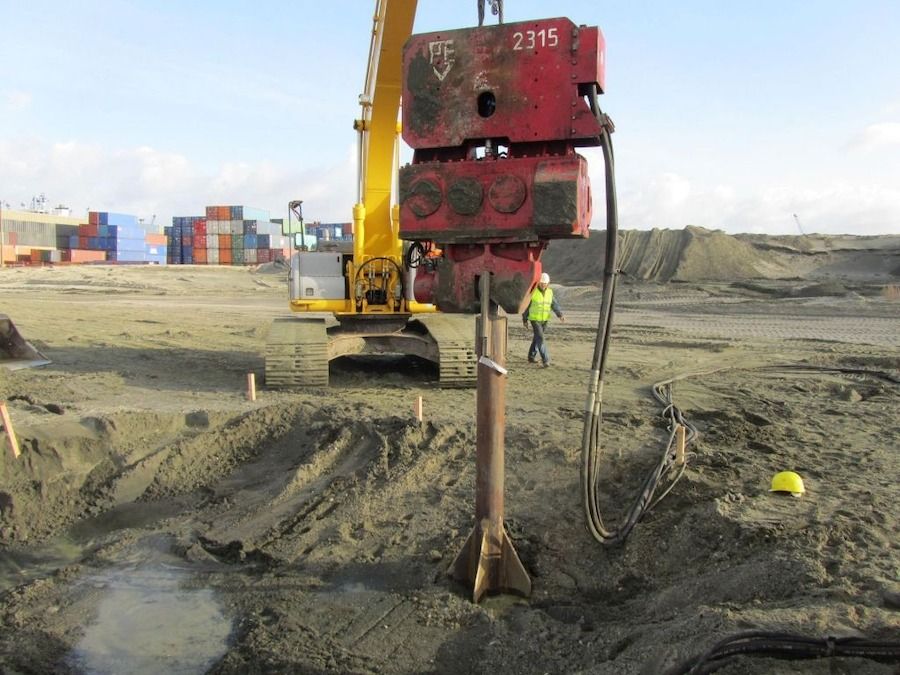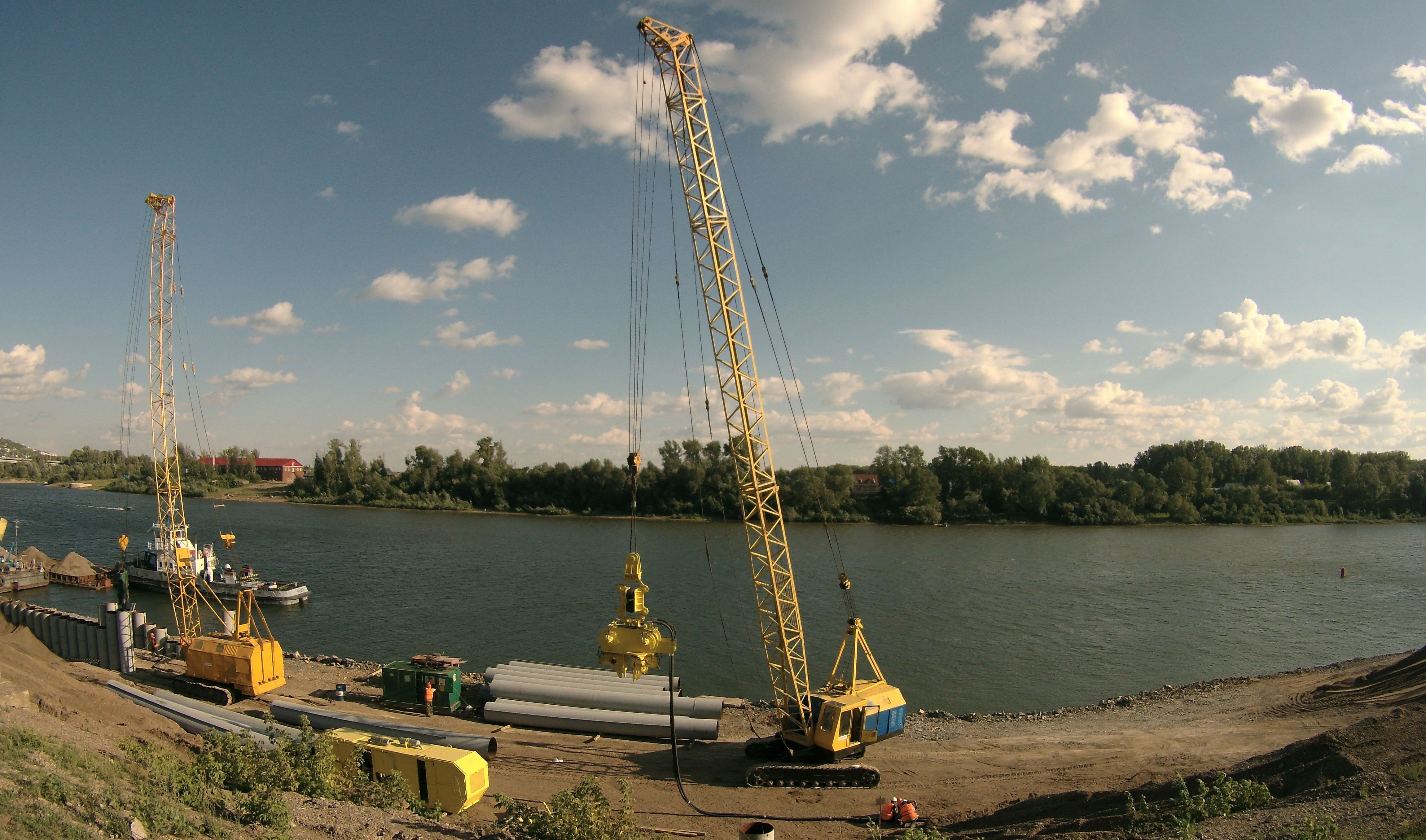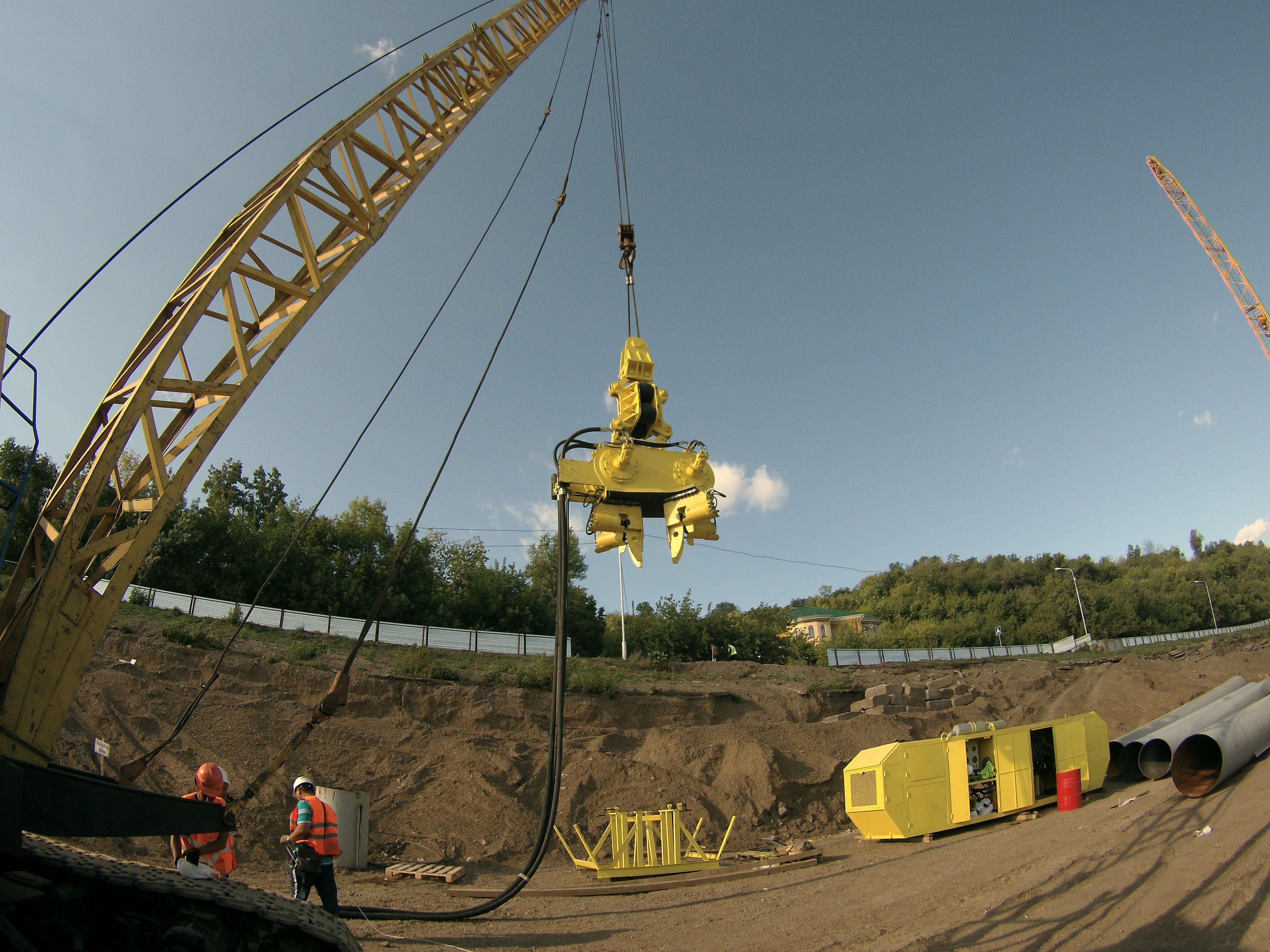Why Vibratory Hammers Matter in Modern Foundation Work
Vibratory hammers are the backbone of modern foundation work. You’ll find them on bridge sites, along coastlines, and deep inside commercial projects.
Why? Because they’re fast, quiet, and effective.
From driving steel sheets into riverbeds to setting piles on tight urban sites, vibratory hammers help crews finish strong foundations—faster and safer.
But here’s the problem: most people don’t fully understand how they work—or when not to use them.
This guide breaks it all down:
- How vibratory hammers work
- Where they perform best
- When not to use them
- How to match the right model to your project
You’ll also learn what to watch for in daily use and why smart setup matters more than horsepower.
If you operate a crane, manage a site, or spec equipment, this guide is for you.
What Is a Vibratory Hammer?
A vibratory hammer is a machine used to drive or extract piles by using vertical vibration. It reduces friction between the pile and surrounding soil, making installation faster and easier.
Instead of pounding the pile like a diesel hammer, it gently shakes the pile into place.
This makes it ideal for
- Urban sites with vibration limits
- Marine jobs where noise must be controlled
- Projects that require fast, repetitive pile work
Key Features of a Vibratory Hammer
- Hydraulic-powered motor that creates vibration
- Eccentric weights to produce vertical force
- Clamp system to grip the pile securely
- Suspension points to mount it to a crane or excavator
Vibratory hammers come in two main types
- Crane-mounted — great for deeper, heavy-duty piles
- Excavator-mounted — better for small- to mid-scale jobs with mobility needs
These machines are often paired with a power pack that controls flow, pressure, and speed.
Explore Crane & Excavator Mounted Models
How Do Vibratory Hammers Work?
Vibratory hammers use controlled vibration to reduce soil resistance and drive piles into the ground. Instead of hitting the pile from above, they shake it — allowing it to slide down under its own weight.
This process is faster, quieter, and easier on your equipment.
Here’s how it works step by step
- Clamp the Pile The hammer's jaws grip the pile tightly — whether it's a steel sheet, pipe, or H-beam.
- Eccentric Weights Spin Inside A motor rotates internal counterweights in opposite directions. This creates vertical vibrations, not side-to-side motion.
- Vibration Transfers into the Pile The hammer vibrates up to 2,000 times per minute. That energy loosens the soil’s grip on the pile.
- Pile Slides Down by Gravity As the soil breaks loose, the pile sinks under its own weight and the downward force of the hammer.
- Once Set, Vibration Stops When the pile reaches the target depth, the operator stops the hammer and unclamps the pile.
Key Components Involved
- Eccentric Block Assembly – Generates vertical force
- Clamp System – Holds the pile securely during vibration
- Hydraulic Motor – Powers the rotating weights
- Suspension Mount – Connects to a crane or excavator
- Power Pack – Controls oil flow, speed, and vibration frequency
Pro Tip: Match your power pack’s hydraulic output to the hammer’s requirements. Undersized flow limits performance and can overheat the system.
Best Use Cases for Vibratory Hammers
Vibratory hammers aren’t one-size-fits-all tools—but in the right conditions, they’re the fastest and cleanest way to drive piles. Below are the most common (and effective) situations where these machines truly shine.
1. Sheet Piling for Cofferdams
In water-based construction, sheet piles are often used to create temporary retaining walls or enclosures. Vibratory hammers install them quickly without damaging nearby structures.
- Ideal for river work, dams, and foundation pits
- Fast installation with minimal noise
- Easy to extract after the project wraps
2. Pipe Piling in Marine Environments
Driving pipe piles for docks, piers, and seawalls is easier with vibratory hammers. They minimize wave disruption and reduce risk to surrounding structures.
- Used on barges and floating platforms
- Works well for steel pipe and H-piles
- Often used alongside vibration dampers to protect cranes
See Marine Pile Driving Solutions
3. Temporary Foundation Work
Need to install piles for a temporary jobsite? Vibratory hammers are fast and reversible. This makes them perfect for staging, temporary bridges, or shoring systems.
- Quick install, easy removal
- No need for permanent anchoring
- Lower environmental impact
4. Bridge Supports and Embankment Walls
For transportation infrastructure, vibratory hammers help place piles for retaining walls, slope stabilization, and support structures—especially near active roads.
- Less disturbance to nearby traffic or buildings
- Safer for soft soil and mixed material zones
5. Noise- and Vibration-Sensitive Sites
Urban zones, hospitals, schools, and aging infrastructure demand equipment that runs quieter and vibrates less. Vibratory hammers meet compliance where diesel hammers often fail.
- Often used in projects requiring environmental permits
- Reduces legal risks and disruption
Vibratory vs Diesel Pile Hammers – Key Differences
Both diesel and vibratory hammers are used to drive piles, but they work very differently. Choosing the right one depends on your soil type, noise limits, project speed, and equipment setup.
Here’s how they compare in real-world conditions
Comparison Table
| Feature | Vibratory Hammer | Diesel Hammer |
|---|---|---|
| Noise Level | Low – suitable for urban or marine use | High – often restricted in populated areas |
| Driving Speed | Fast for loose or sandy soil | Better in dense or rocky soils |
| Setup Complexity | Moderate – quick clamp and go | High – requires alignment and staging |
| Fuel Requirement | Hydraulic via power pack | Diesel combustion |
| Use Cases | Marine, urban, temporary jobs | Deep foundations, dense soil layers |
Key Takeaways
- Use vibratory hammers when speed, noise control, and repeat pile driving are top priorities.
- Choose diesel hammers when you’re dealing with hard soil layers or extremely deep foundation piles.
Explore Hydraulic Power Packs for Vibratory Hammers
Advantages of Using Vibratory Hammers
Vibratory hammers have become the go-to choice for many contractors—especially those working near sensitive structures or under tight project deadlines.
Here’s why they stand out
- Faster Installation Vibratory hammers drive piles quickly through soft to medium soil. This reduces crane time and overall labor costs.
- Less Structural Impact The controlled vibration reduces stress on nearby buildings, pipes, or utilities—making it ideal for urban zones and retrofits.
- Longer Equipment Life When paired with a vibration damper, vibratory hammers create less force back through the boom, reducing crane wear and maintenance.
- Quieter Operation Many job sites now require low-noise equipment. Vibratory hammers help you stay within limits without sacrificing performance.
See Vibration Dampers for Crane Protection
When NOT to Use Vibratory Hammers
Vibratory hammers are powerful, but they’re not ideal for every condition. Using them in the wrong setting can reduce efficiency, cause damage, or fail to drive the pile completely.
Avoid using them in these scenarios
- Rocky or Extremely Dense Soil Vibratory energy doesn’t break up rock. In solid layers, the hammer may stall or overheat.
- Friction Piles in Dry Sand In some soil types, piles rely on friction instead of depth. Vibration can reduce holding power by loosening the surrounding soil.
- Sensitive Equipment Nearby In some industrial zones or lab settings, resonance from vibration can damage calibration-sensitive tools or cause unwanted ground movement.
Maintenance & Setup Tips for Operators
To keep your hammer running safely and efficiently, basic checks before and after each use are critical. Here’s what to focus on:
Daily Inspection Points
- Check jaw condition for wear or cracks
- Inspect hydraulic lines for leaks or pressure loss
- Listen for unusual sounds in the eccentric housing
Clamp Adjustment
- Make sure clamps match pile type and size
- Always check tightness before and during operation
Lifting & Transport Tips
- Use rated shackles and lifting slings
- Ensure suspension mount is balanced and centered
Service Intervals
- Visual check: daily
- Grease moving parts: weekly
- Full inspection: every 6 months or 1,000 hours
Pro Tip: Use a vibration damper between the crane and hammer. It reduces boom fatigue and lowers the risk of cracks over long jobs.
How to Choose the Right Vibratory Hammer for Your Job
Not all hammers are equal. Choosing the right model depends on the pile, soil, and support equipment.
Key Selection Factors
- Pile Type & Soil Condition Match hammer specs to the type of pile (sheet, pipe, H-beam) and soil density.
- Mounting Type Crane-mounted hammers handle deeper drives. Excavator-mounted models work better for mobile, mid-scale jobs.
- Driving Force in kN Use soil data and pile specs to calculate how much downward energy is needed.
- Power Pack Compatibility Ensure the flow rate and pressure from your power pack match the hammer’s hydraulic requirements.
The Right Tool for the Right Soil
Vibratory hammers are one of the most versatile tools in foundation work. They’re fast, efficient, and well-suited for soft to medium soils, marine jobs, and tight urban spaces.
Use them wisely. Match the model to your job. Maintain them properly. And always consider site conditions before choosing.
Need help picking the right model?
Contact Us for Model Match or Consultation




